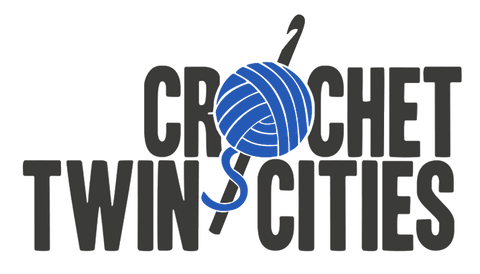The Textile Center of Minnesota is our new meeting place, and we love it here! There is great light, a podium for the presenters, lots of tables and chairs. Best of all, we have the space from 11:00 am until 3:00 pm so folks can come early for "open crochet" and visiting.
At the recent October 12 meeting, we started with member and visitor introductions, then reviewed some housekeeping details:
- Parking directly behind the Textile Center is very limited so be sure to review the parking information found at http://www.textilecentermn.org/map/. If possible, please use the flat lot 1 ½ blocks northeast of the Textile Center (you need exact change, cost is $3).
- Feel free to come early for open crochet time starting at 11:00 am.
- It is fine to bring lunch, food, or beverages into the room but we need to remove all trash when we leave.
Next came announcements and November is going to be a busy month!
- A Textile Center fundraiser, Do or Dye, will take place on Thursday, November 7, 2013 from 5:00-9:00 pm. This is a make-and-take fundraiser where you can explore new skills. Tickets are $50. Julie and Rosemary will represent Crochet Twin Cities and offer lessons in crochet headbands, necklaces and bracelets. For more information, see http://www.textilecentermn.org/do-and-dye/
- The Fall Fiber Festival will be on Saturday, November 2, 2013 from 9:00 am- 4:00 pm at the Eisenhower Community Center, 1001 Highway 7, Hopkins, MN 55305. This festival attracts and promotes local fiber and fiber products andCrochet Twin Cities will have a table at this event. We need volunteers to staff the table during the event - to demonstrate crochet and answer questions anyone might have about our craft or our group. Send a note to ctclist@gmail.com if you can help at our table. Further information about the Fall Fiber Festival is available at: http://www.fallfiberfestival.com/
- The membership committee reminded everyone to complete the survey; paper copies are available if you prefer that to the online form. The membership committee will meet on November 9 during open crochet time to review the survey results and plan next year; anyone is welcome to attend.
- Our new membership year starts in January; dues can be paid anytime in November or December.
- Our next regular meeting will be on November 9, where we will learn about crocheting cables. There is also a 5th Saturday this November so stay tuned for an activity on the Thanksgiving holiday weekend.
After announcements, Hillary continued our 2nd session on Clones Lace, also known as Irish Lace. She took a class from Marie Trenor at the James J. Hill House several years ago; Jo and Maxine assisted with the teaching as they have also had some experience with this lace.
Once your motifs are made, you need to join them. The background joining is freeform crochet meaning that you design it to be whatever appeals to you. It is best to plan ahead, and keep the pattern consistent. You will need to decide how open to make the design by varying the length of the chains lining areas; shorter chains produce a more traditional, denser look. Hillary prefers to do her joining work on paper rather than a fabric background; she advises using a brown paper grocery bag for ideal stiffness. Pin your central motif to the paper, then attach to your motif and start to work your background design.
A hallmark of Clones Lace/Irish lace is the use of Clones knots in the background pattern. These knots are the hardest part of the process, and most of the session was devoted to practicing them. Hilary provided a step-by-step handout as well as hands-on instruction.
An excellent resource is “Clones Lace” by Marie Treanor. It includes history of the lace, copious photographs, lots of examples, and directions for both motifs and finishing. (This book can be ordered from
http://lacis.com/catalog/, just type Clones Lace and click the Search button to locate the title.)
 If you think beautiful cables are just for knitting, think again! At this month's meeting we'll learn how to use post stitches to create beautiful crochet cables - from simple to advanced. During the class, you'll have the opportunity to work on a sampler that matches your skill level.
If you think beautiful cables are just for knitting, think again! At this month's meeting we'll learn how to use post stitches to create beautiful crochet cables - from simple to advanced. During the class, you'll have the opportunity to work on a sampler that matches your skill level.














